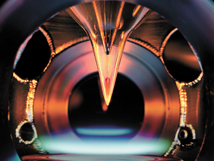Team discovers unsuspected intermediates in the chemistry of combustion

Combustion Chemistry Dept. 8353 researchers Craig Taatjes, Nils Hansen, Andy McIlroy, Jim Miller, Juan Senosiain, and Stephen Klippenstein are part of an international team that published a Science Express paper May 12 about the surprising detection of a class of compounds previously unknown in flames. This result could have implications for areas as diverse as understanding pollutant formation in combustion and modeling interstellar chemistry.
The discovery of these compounds, called enols, is the biggest breakthrough so far from a powerful new flame chemistry probe, operated at the Advanced Light Source at Lawrence Berkeley National Laboratory (LBNL), that was developed by researchers from Sandia, LBNL, Cornell University, and the University of Massachusetts in late 2002.
This machine, and a similar device operating at the National Synchrotron Radiation Laboratory in Hefei, China, investigate molecules sampled from flames by combining mass spectrometry (to reveal molecular weight) with ionization by vacuum-ultraviolet light emitted from a synchrotron. One key capability of the machines is that they are able to distinguish isomers — molecules made of the same atoms but in different arrangements — that can have very different chemical characteristics. Enols are less-stable isomers of other well-known combustion intermediates.
They were found when the team was looking for signatures of different isomers in flames. With this finding, enols can be added to predictive computer models currently used to improve combustion efficiency and cleanliness.
“It is remarkable that, even after 150 years of flame chemistry research, new compounds can be found in flames,” Craig says. “Enols themselves are chemically interesting; they were predicted to be transient chemical intermediates in 1880, but the first direct observation of the simplest enol, vinyl alcohol, wasn’t until 1973. Although these compounds have been elusive,” he adds, “it turns out they are just sitting in flames.”
The unanticipated detection of enols could also have a significant impact in refining models used to describe fuel cell operation and emission-free waste cleanup using supercritical water oxidation, Craig says. Astronomers have also observed ethenol (one of the enol compounds now identified in flames) in interstellar space. The new enol findings may provide clues as to how complex organic molecules form in interstellar space.
Besides the Sandia scientists, the team that discovered enols in flames includes researchers from Cornell University, the University of Massachusetts, the University of Bielefeld (Germany), and the National Synchrotron Radiation Laboratory in Hefei, China .